16 proven steps to create an email marketing strategy that works
 Indrė, CEO, and Paulius, content marketing team lead.
Indrė, CEO, and Paulius, content marketing team lead.
An effective email marketing strategy is, hands down, one of the best ways to grow your small business. We regularly speak to brands that drive big results thanks to their engaged lists of valuable subscribers.
This travel agency’s email marketing strategy is so successful that it has to split its list when sending offers so its sales team isn’t overwhelmed by inquiries
This e-commerce store consistently turns one-time buyers into repeat customers with email promotions and automations
This online course provider successfully sells out new courses in under 24 hours, thanks to his engaged list
But when you're starting with nothing, it’s hard to know how to achieve results. How do you grow your list? What automations should you use? How do campaigns actually lead to sales?
We’ll share the answers to these questions and more in this article. Plus, we’ve got plenty of stats and examples to highlight each point.
1. Define your audience
Be clear about who will receive your emails. This lets you send the content and offers that matter to them.
Most email lists contain existing buyers and potential customers who are interested in your brand but are yet to purchase. Each audience type requires different email content.
Beyond these two main groups, you’ll also have people with varying interests, demographics, challenges, and needs.
You can use data collected in your email marketing platform to get this deeper information.
MailerLite users can see:
The subscriber’s location based on the IP address used when they joined your list
If and how many times they’ve ordered from your brand
The total value of all their orders
How much they engage with your campaigns
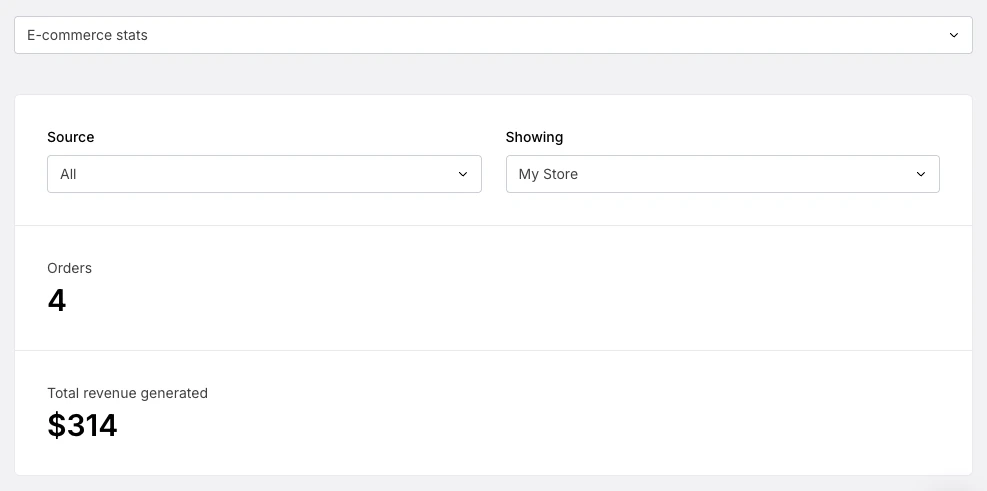
MailerLite also allows you to send email surveys that you can use to learn more about your subscribers.
When creating a survey, think about the type of information that will help you build more effective campaigns and include questions asking for this information.
You could share the survey in your welcome email, in a message sent to your most engaged email subscribers, or simply in a campaign that goes out to your entire list.
2. Set your goals
Almost any business will benefit from email marketing. Our email marketing success stories include businesses that use email to:
Drive sales
Increase customer value
Encourage preorders
Increase customer loyalty
Pack out events
Convert website visitors into paying customers
Sell travel tours
Build customer relationships
Improve the customer experience
Monetize a community
Onboard SaaS customers
And more!
With so many options, the key is to define your most important business goals and choose which ones to focus on.
Also, consider the metrics and data points that will show whether the strategies are working. If you want to convert website visitors into customers, measure form conversion and use e-commerce tracking to see the percentage of people who buy after receiving the email.
3. Set up a reliable signup process
An email marketing strategy only works if you have subscribers to contact. Most signup strategies work by building an audience on a specific platform and then converting some of these people to your list.
This could be:
Creating a website and using signup forms to convert visitors
Growing a social media following and using lead magnets to convert subscribers
Attracting an audience offline and collecting subscribers in person
Creating an online store and letting people join your list at check out
Getting in front of other people’s audiences via podcasts
Choose a strategy that works with your existing strengths. If you already have a social following, it will be easier to convert these people than to grow an entirely new audience on another platform.
Remember that for most businesses, a smaller number of high-quality subscribers is better than a large number of low-quality ones. Also, privacy regulations like GDPR mean you need to get opt-in consent from each subscriber.
Find out more about strategies that can help you grow your list here.
4. Create a sign-up offer
Simply asking people to join your list isn’t the most effective way to grow. A better option is to incentivize signups with an enticing offer.
This will typically be either a:
Lead magnet: A helpful resource about a topic related to your business that people download in exchange for their email address
Discount offer: A coupon that people can access by providing their email address
A discount offer is the easiest way to start since it requires no work. And while it can reduce the profitability of the purchase, it can also be an effective way to get the purchase over the line.
Add forms to your product pages or pop-ups that appear when a subscriber has shown interest in your brand. Use a welcome email automation to send the coupon code as soon as people sign up. You can even use spin the wheel pop-ups to offer multiple offers with different values.
If you choose to use a lead magnet to grow your list, save time by repurposing your existing content marketing resources.
You can then create more targeted resources for different types of leads or customers. At MailerLite, we have resources for e-commerce stores, non-profits, education companies, and more. See an example for non-profits below.
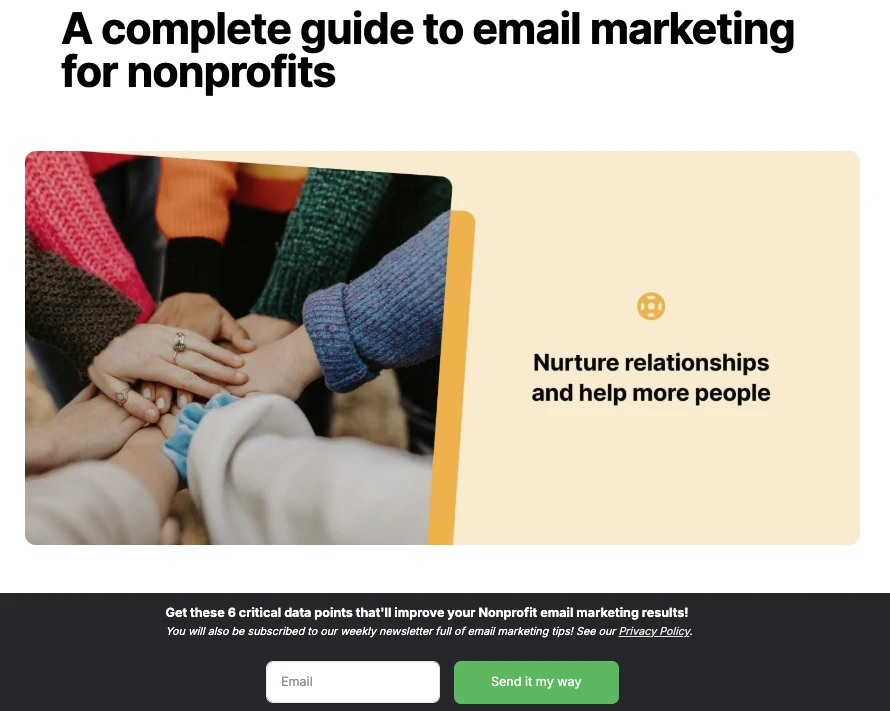
5. Create an email template
A good email template is an essential part of any email marketing strategy since it lets you create emails that are always on brand. Plus, creating each email is much faster when you start with a template.
With MailerLite, you can turn any email built with our platform into a template. You can also customize any of the 90+ pre-built templates in our template library.
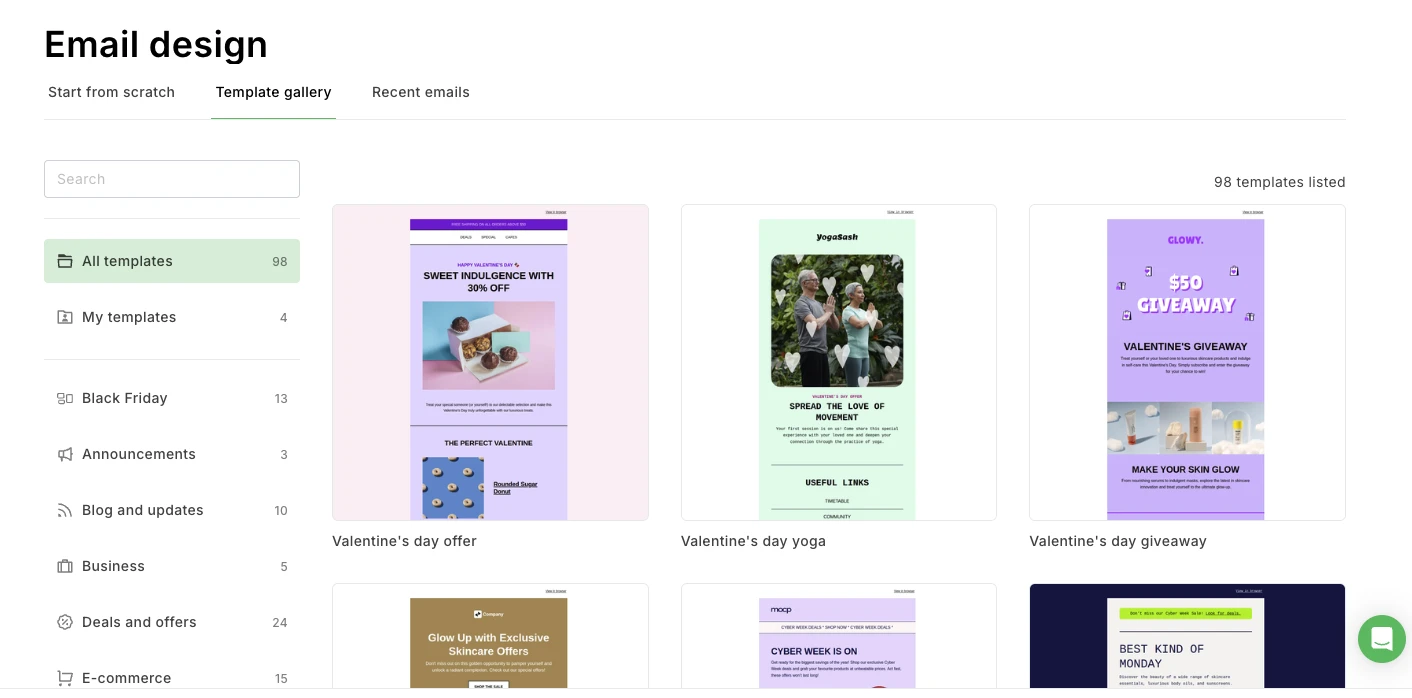
Start by defining sections contained in every email newsletter, such as headers, footers and images.
Next, create and save blocks that you can reuse across each campaign. This could be different types of product blocks or blocks for promoting blog posts, events, or resources. Once saved, you can easily drag these into any email.
When you finish your template, choose the option to save it as a template in the MailerLite builder. You can then start from this email design whenever you create a campaign or automation.
6. Plan your email marketing campaign content
Email marketing strategies typically consist of campaigns, which are one-time emails sent to a targeted list, and automations, which are pre-scheduled sequences triggered by subscriber actions.
Campaigns take more work as you have to create new ones for every send, but they can be extremely effective. Our analysis of e-commerce stores found that over 93% of tracked sales came from campaigns.
The key to effective campaigns is choosing a content format that is effective and not too time-consuming. Think about the types of content that will appeal to the target audience and the goals defined in the earlier steps.
Some common content types to include in campaigns are:
New product releases
Sales and discounts
Customer testimonials
Helpful content and resources
The exact content you send will depend on your brand. E-commerce stores get a lot of value from sending product and offer-related content. Businesses in the services industry can send thought leadership content to position themselves as experts.
And software brands can share educational content to teach recipients how the product can help. It all just depends on your audience and goals.
7. Plan your campaign frequency
Most brands find that sending campaigns at a regular cadence helps them plan their emails and helps customers know when to expect contact.
Choose a frequency that allows you to say or share something new and interesting with every send. An e-commerce store with an ever-changing lineup of products and promotions will get away with sending more emails than one with a small, static product lineup.
Either way, you can probably send more emails than you think. Our analysis of email sending cadence found that there is only a small difference in opens and clicks between emails sent multiple times per week and those sent once or twice a month.
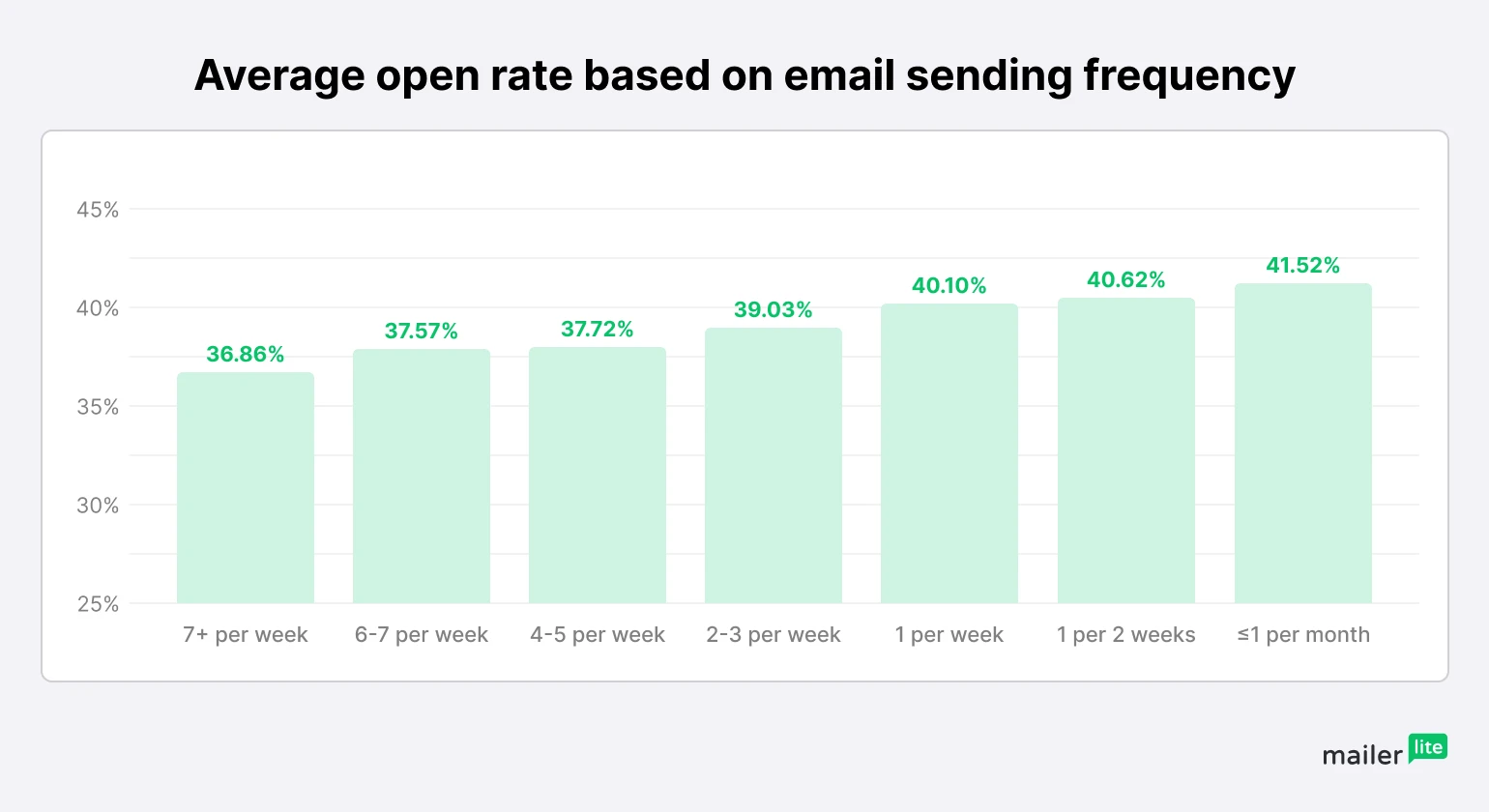
If you generate a high volume of new subscribers, consider adding real-time verification to your forms to stop low-quality addresses from making it onto your list in the first place.
People with a large email list will also benefit from the inbox insight and placement features as it increases the chances that your emails will end up in the recipient’s inbox, rather than the spam folder.
8. Create your automations
Automations are emails that go out when when triggered by an action or condition, such as welcome emails or post-purchase messages. Set them up once, and they work continually until you deactivate them.
Automations generate incredible engagement since they send the exact content someone is looking for at the time they are interacting with your brand.
Our analysis of e-commerce stores found that the first email in an automation gets an average open rate of 64% and a click rate of 21.32%, far above the average for campaigns, which stands at 41.73% and 6.69%.
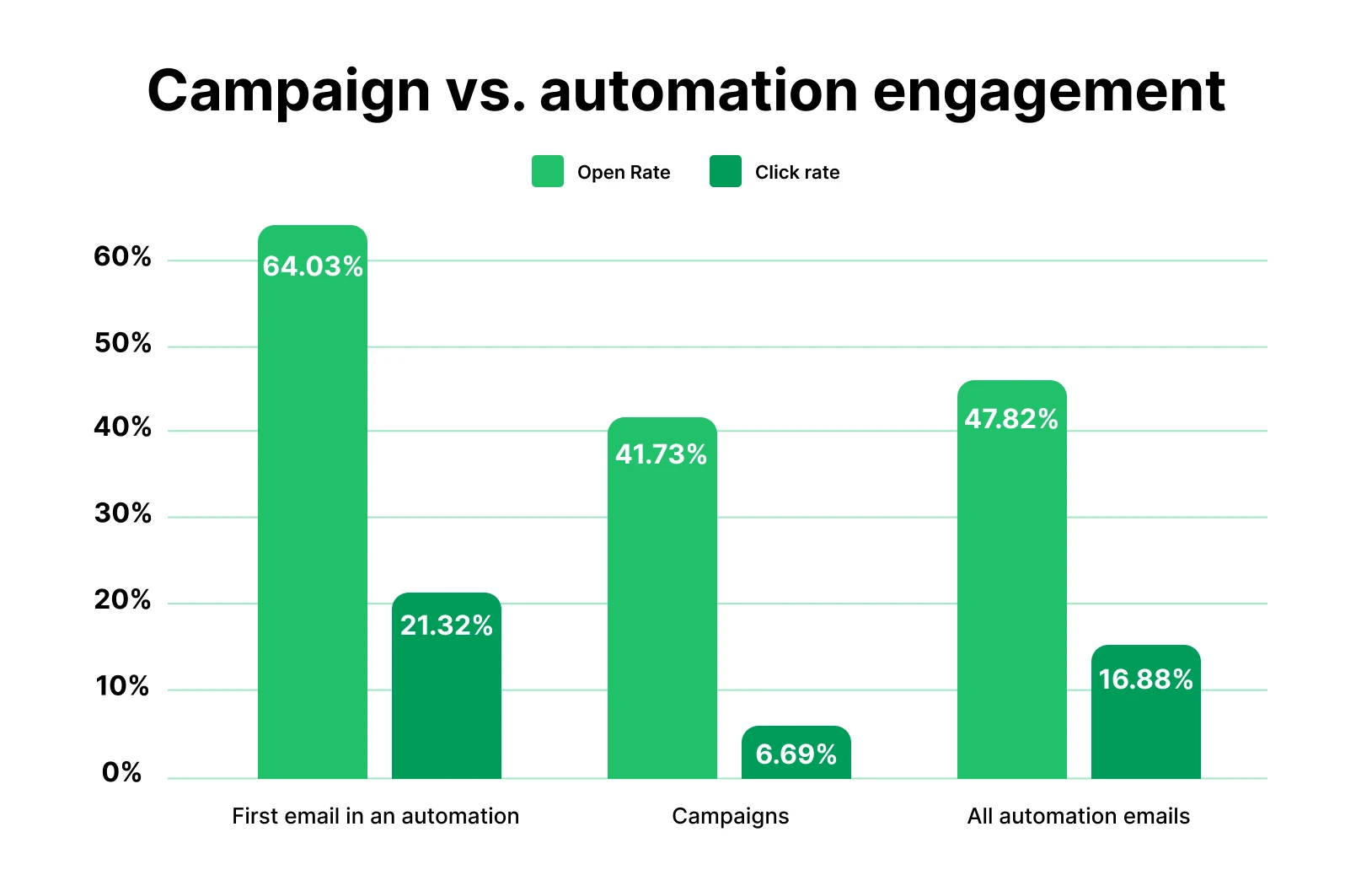
But what automations should you use? Almost all businesses will benefit from a welcome email that introduces people to your brand when they sign up for your list.
Beyond this, the key is to think about your goals and the ways that people interact with your business. You can then create automations that streamline the process.
Here are some examples:
Nurture new signups with welcome offers
Send upsell offers to buyers
Remind signups about events
Send related products when someone clicks on a category link in an email
Send birthday emails
There are tons of possibilities when it comes to creating automations, from single automated emails to longer sequences with conditions that change based on engagement.
You just need to understand how triggers work. Read our article on email automation triggers to find out more.
9. Create segments and groups
One of the simplest ways to get more email engagement is to send relevant information to the right subscribers with email segmentation and groups.
Our data shows that when e-commerce stores filtered email subscribers, they got opens and click-through rates that were 36.69% and 267.21% higher than non-targeted campaigns.
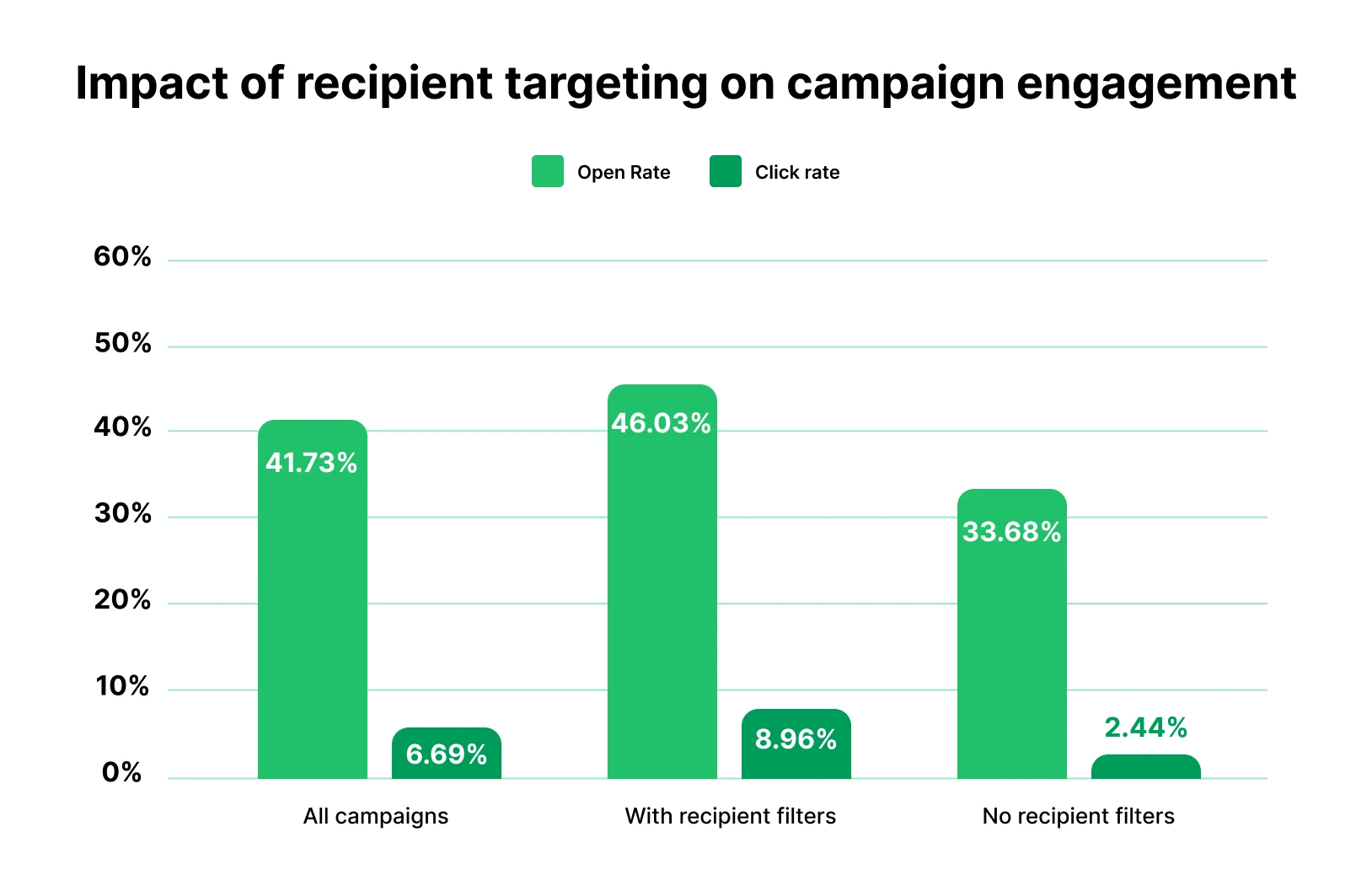
Segments are dynamic subscriber lists that people join and leave automatically based on rules like the person’s location, email engagement, updated subscriber fields, or shopping behaviors.
Groups are static lists that you can create based on the method someone uses to join your list, steps in a marketing automation, or actions from a third-party integration.
As well as groups and segments, you can target emails based on signup source, location, campaign engagement, custom fields, and even specific email addresses.
Once you’ve created your targeted lists, send them relevant content. Think about what each group will find useful.
You could send review request emails to customers who have made multiple orders or product recommendations to people who joined your list via a lead magnet that highlights their interests.
For example, the filtering options below would allow a business to send a promotion to anyone who clicked on a link to their latest product but didn’t actually buy it.
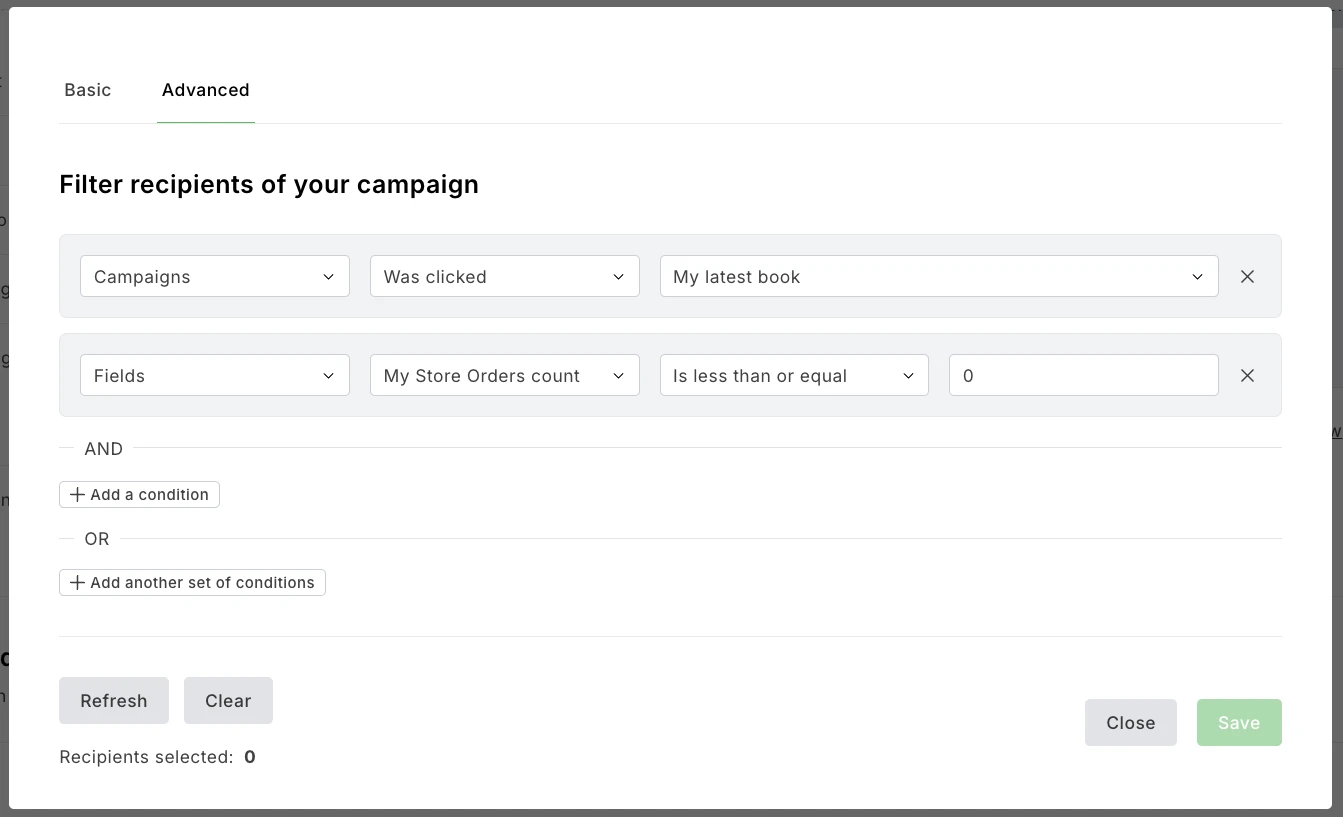
10. Personalize your emails
Another way to target your emails is to use dynamic content that changes depending on who receives it.
This could be adding data from a field in their profile, such as their name, to the email content or adding entire content blocks and configuring the settings so it only appears for specific groups.
One effective way to use this feature is to tailor your offer messaging to different segments. For example, you could show a 10% discount off first purchases to people who are yet to buy. Then you could show existing customers a 30% discount if they upgrade to an annual plan.
11. Hone in on effective messaging with A/B testing
A/B testing (also known as split testing) tests different email elements by sending out 2 versions of a campaign to see which gets the most engagement. It’s a super effective way to optimize your messages.
These tests are useful because they highlight the kind of messaging and offers that your audiences respond to. You can then send the most effective version to the majority of your list and use the learnings to guide future campaigns.
Consider testing:
Email subject lines to see which gets the most opens
Offer messaging and call-to-action (CTA) text to see what gets the most clicks
Product images to see what people click on
Sending names and times to see what results in more opens
While A/B testing lets you test 2 versions of an email, you can also use multivariate testing to test multiple versions simultaneously.
12. Stay up to date with trends and strategies
Effective email marketing trends and strategies change with time. This year, people are having a lot of success growing their lists on social media with automated DM tools. While AI and AI transparency are providing opportunities for creating content and building trust.
Keep an eye on the promotional emails you receive to see the types of marketing campaigns that stand out. We also share plenty of email marketing inspiration on our social media channels. Hit the post below to check us out on Instagram.
13. Create a strategy to re-engage inactive subscribers
As time goes on, some subscribers will inevitably stop interacting with your content. Use a re-engagement campaign to reignite their interest.
Find your unengaged subscribers by heading to the Subscribers section of your MailerLite dashboard and then using the Time inactive filter to find subscribers who haven’t opened or clicked on your emails in your chosen period.
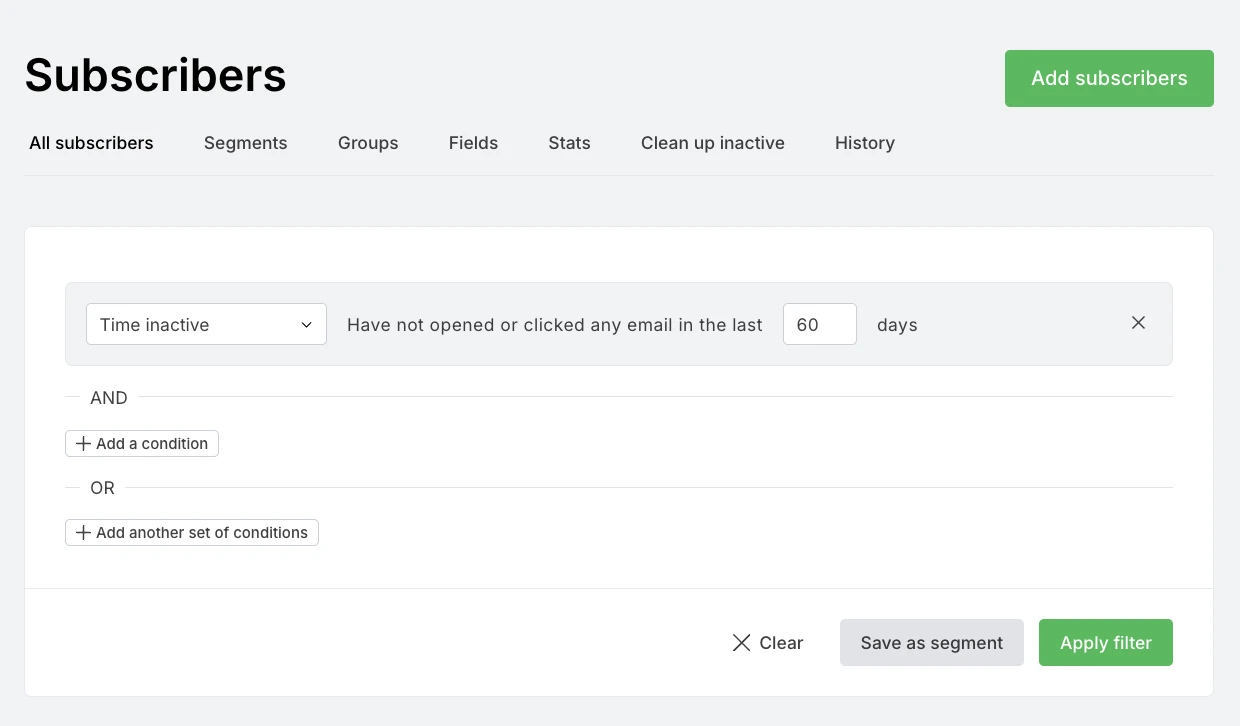
You can then select all of these subscribers, create a group for them, and send a targeted campaign or an automation that goes out when people join the group.
For a re-engagement campaign to work, you need to send a message with a subject line that stands out from your usual content. Special offers can work, as can simply asking the question “Do you still want to hear from us?”.
If people interact with this message, continue sending them emails. If they don’t remove them from your list. Find out more about creating a re-engagement campaign here.
14. Use behavioral data
Behavioral data such as email clicks and opens is a treasure trove of information you can use to create targeted promotional emails.
Our research found that the behavioral trigger When subscriber clicks a link was the automation trigger with the second-highest open and click rate. It was also one of our least-used triggers, making it a good opportunity for the businesses that aren’t yet using it.
The trigger is effective because someone clicking on a link shows that they are highly engaged with your brand while providing crucial information about the exact product, challenge or topic they are interested in.
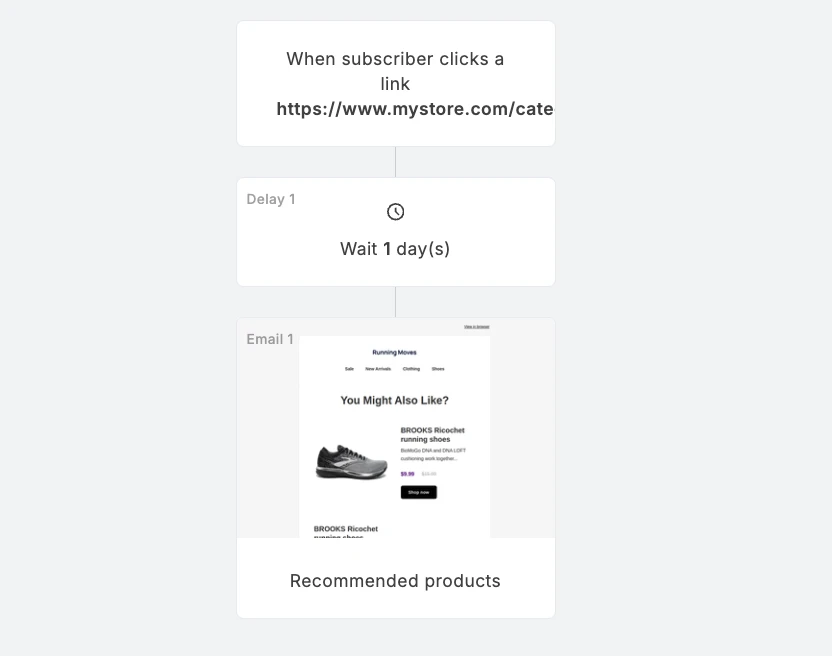
You can use this information to send relevant content to help generate a sale. For example, if a subscriber clicks on a:
Product category: Send top products from that category
Specific product: Send a discount or more information if they didn’t complete the purchase
Content resource about a specific challenge: Follow up with content about how your product can help
MailerLite also lets you use other behavioral triggers such as people buying products, abandoning a cart, completing a form, or even opening emails.
15. Create an audience growth flywheel
We mentioned in point 3 that you can use your existing digital marketing channels to grow an audience and convert them to your email list.
Once you have an email list, you can also use this to repay the favor and give your other channels a boost.
Consider sharing your latest social posts or videos in your emails. The posts you share will get an engagement boost that could result in more visibility. This, in turn, could lead to more email list signups. That’s the flywheel in action.
16. Optimize your strategy with metrics
As you start sending campaigns, you’ll generate a ton of data that you can use to optimize your future email marketing efforts.
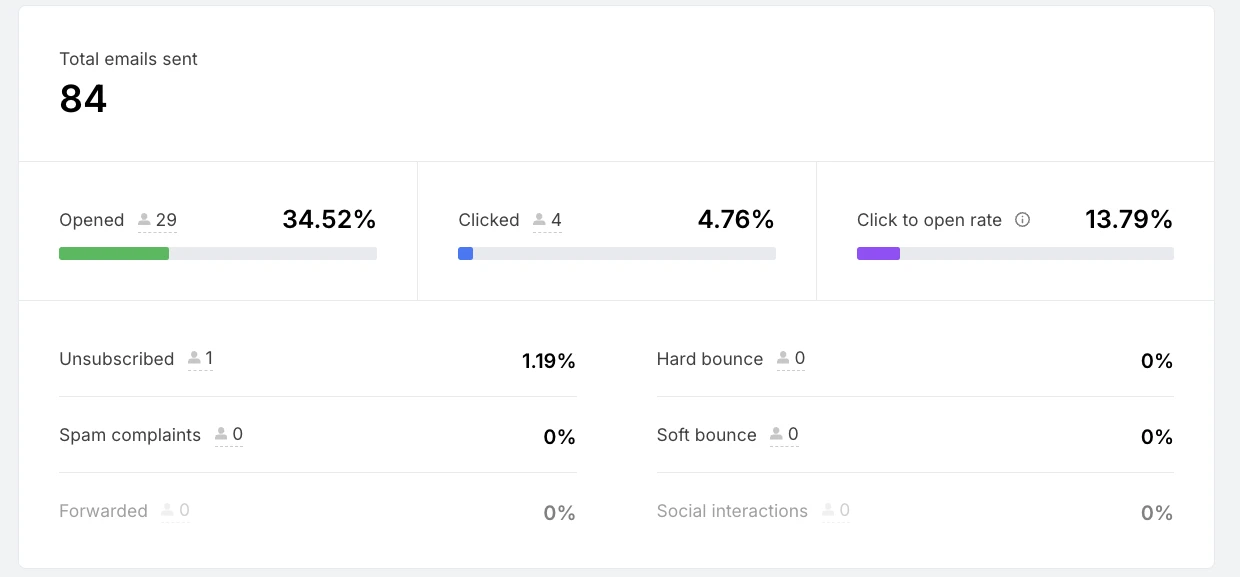
Here are the key email marketing KPIs to follow. You can typically see these in your email marketing software’s dashboard.
Open rate: The percentage of recipients who open your emails
Click rate: The percentage of people who click on your emails
Click to open rate: The percentage of the people who opened your email who also clicked on it
Orders: The number of orders each email generates (you need a connected store)
Revenue: The value of the orders generated by the email (you need a connected store)
Unsubscribe rate: The number of people who clicked the email’s unsubscribe link
New subscribers: The number of new subscribers who join your list in a given period
Conversion rate: The percentage of people who join your list out of those who see a form, pop-up or landing page
Bounce rate: The percentage of emails that couldn’t be delivered
Tracking these metrics over time will show you which topics, subject lines, offers, and content the people in your audience interact with most.
You can also compare your campaigns to those from others in your industry. We analysed data from over 3 million campaigns sent via MailerLite and found that the benchmark open and click rate is 42.35% and 2%, respectively.
This number varies a lot depending on industry and location. Read our full email marketing benchmarks article for more.
Check what works and keep going
Email marketing strategies are ever evolving. Once you’ve used the marketing tips in this article to get started, keep optimizing and adding to your strategy to make it more effective.
Over time, you’ll end up with a strategy that continually pushes you towards your marketing goals.
Grow your business with email
Get all the tools you need to create successful email marketing campaigns. Grow your list with forms, generate sales with campaigns and automations, and track and optimize with testing and analytics. Start your free trial today.
Editor's note: This article was first published in 2023 and has since been refreshed with up-to-date content.
